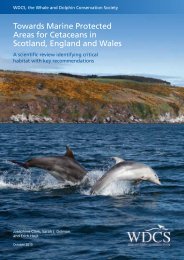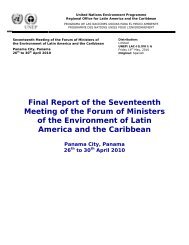Sea Turtle Recovery Action Plan for Barbados - WIDECAST
Sea Turtle Recovery Action Plan for Barbados - WIDECAST
Sea Turtle Recovery Action Plan for Barbados - WIDECAST
Create successful ePaper yourself
Turn your PDF publications into a flip-book with our unique Google optimized e-Paper software.
<strong>Barbados</strong> <strong>Sea</strong> <strong>Turtle</strong>s …<br />
2.2 Chelonia mydas, Green <strong>Sea</strong> <strong>Turtle</strong><br />
Local common names <strong>for</strong> this species include green turtle and green-back. Green turtles<br />
are recognized by a single pair of scales on the <strong>for</strong>ehead between the eyes and a round, blunt<br />
beak serrated <strong>for</strong> clipping sea grasses. The carapace is smooth and the plates (=scutes) do not<br />
overlap one another (in contrast to the hawksbill turtle, see section 2.4). The carapace is<br />
characterized by four pairs of lateral scutes (Figure 1) and is generally free of barnacles. Adults<br />
attain weights of 230 kg and generally measure 95-120 cm straight-line carapace length (nuchal<br />
notch to posterior tip) (Pritchard et al., 1983). Individuals of varying sizes are present in the<br />
waters surrounding <strong>Barbados</strong> throughout the year.<br />
Green turtles are herbivorous and in the Caribbean they feed primarily on the sea grass<br />
Thalassia testudinum (Bjorndal, 1982). Field studies indicate that individual turtles maintain<br />
feeding "scars" by returning to the same area of sea grass meadow to <strong>for</strong>age everyday (Bjorndal,<br />
1980; Ogden et al., 1980, 1983). These scars, or grazing plots, are maintained by regular<br />
cropping <strong>for</strong> several months and the more digestible newer growth (higher in protein, lower in<br />
lignin) is preferred (Bjorndal, 1980). When the cropped grasses show signs of stress (blade<br />
thinning, increased inter-nodal distance), the turtle generally abandons the scar and moves on to<br />
<strong>for</strong>m another. <strong>Sea</strong> grasses are relatively rare in <strong>Barbados</strong>. The best developed <strong>for</strong>aging areas are<br />
found on the south coast and in protected bays on the east coast (section 4.111) (Map 2).<br />
There are no documented incidents of green turtles nesting in <strong>Barbados</strong>, although a single<br />
hatchling was found in 1990 on land at a site far from the sea. Where it came from and how it<br />
got there are unknown. Adults are occasionally caught opportunistically offshore (usually<br />
speared), but they are rarely seen in coastal waters. In contrast, juveniles (5-18 kg in weight) are<br />
relatively common in coastal waters, especially on the east coast. Some fishermen take them<br />
opportunistically and more rarely set nets <strong>for</strong> them, although those they catch are often below the<br />
30 lbs (13.6 kg) legal size limit (see section 4.21). Green turtles are long-lived and require 25-35<br />
years to reach sexual maturity in the Caribbean (Frazer and Ladner, 1986). Age structure of the<br />
population(s) feeding in the waters of <strong>Barbados</strong> has not been studied.<br />
2.3 Dermochelys coriacea, Leatherback <strong>Sea</strong> <strong>Turtle</strong><br />
Leatherbacks are the largest of all the sea turtles (nesting females often weigh 300-500<br />
kg) and they have the most extensive geographic range of any turtle. Aside from their great size,<br />
leatherbacks are easily distinguished because they lack a bony shell. The smooth, black skin is<br />
spotted with white. The carapace is strongly tapered, measures 130-165 cm in length<br />
(straight-line, nuchal notch to posterior tip), and is raised into seven prominent ridges (Figure 1).<br />
Powerful front flippers extend nearly the length of the body. Adults, at least adult females, are<br />
excellent divers, having been recorded at depths exceeding 1000 meters in Caribbean waters<br />
(Eckert et al., 1989). Leatherbacks feed predominately on jellyfish and other soft-bodied prey<br />
(Den Hartog and Van Nierop, 1984; Davenport and Balazs, 1991). Based on offshore studies of<br />
diving by gravid (=egg-bearing) females nesting in St. Croix, Eckert et al. (1989) proposed that<br />
inter-nesting dive behaviour may reflect nocturnal feeding on vertically migrating zooplankton,<br />
chiefly siphonophore and salp colonies.<br />
Page 3

















